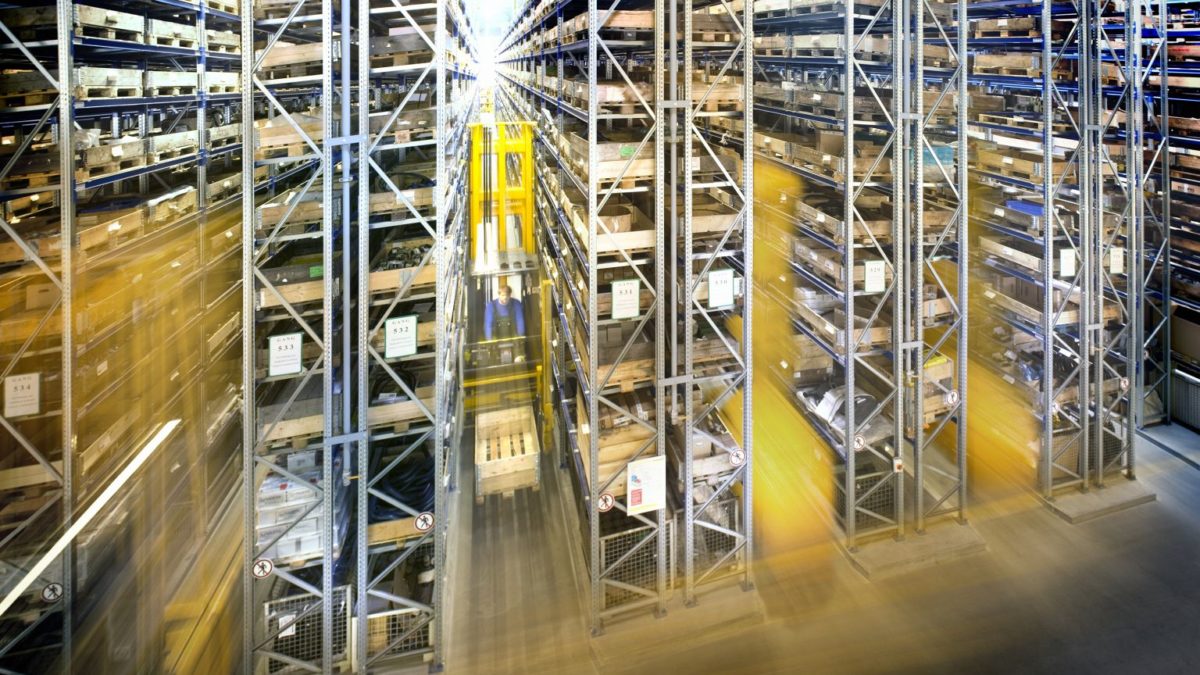sales@lufapak.de +49 2631/384-0 Contactform
A decentralised warehouse, as opposed to the traditional, centralised warehousing model, distributes stock across different locations closer to the end customer. This strategy not only enables faster delivery of goods to customers, but also helps to reduce transport costs and improve responsiveness to market changes. In a world where the demand for fast and flexible delivery is constantly increasing, the decentralised warehouse concept is an attractive solution for companies looking to optimise their logistics networks. This article provides a comprehensive overview of the definition, advantages and disadvantages as well as practical examples of decentralised warehouses to create a better understanding of this modern warehousing concept.
Decentralised warehouse definition
The concept of a decentralised warehouse refers to a strategy in logistics and warehousing where stock is stored across multiple, geographically dispersed locations rather than in a central warehouse. This method aims to bring stock closer to the end user in order to shorten delivery times, reduce shipping costs and ensure greater flexibility in dealing with fluctuations in demand. Unlike the centralised warehouse model, where all stock is concentrated in a single location, the decentralised warehouse allows for a more efficient distribution of goods, which is particularly crucial in the era of e-commerce and the expectation of fast deliveries.
A decentralised warehouse offers companies the opportunity to adapt their warehousing and distribution to the dynamic demands of the market. By distributing stock across multiple locations, a company can strengthen its presence in different regions and thus increase customer satisfaction through shorter delivery times and improved service. This strategy is particularly beneficial for companies that serve a wide range of geographic markets and need to respond to sudden changes in demand or supply disruptions.
The decision between a centralised and decentralised warehouse depends on various factors, including the type of products, the size and geography of the market and a company’s specific business objectives. While a decentralised warehouse model offers a number of benefits, it is important to carefully consider the associated challenges, such as higher operational costs and complexity in warehouse management.
Advantages and disadvantages of decentralised warehouses: a comparison
The decision between a decentralised and a centralised warehouse concept is crucial for companies, as it has a significant impact on the efficiency of the supply chain, customer satisfaction and ultimately on the company’s success. In order to make an informed decision, it is important to take a close look at the advantages and disadvantages of a decentralised warehouse.

Decentralised warehouse Advantages:
- Greater delivery flexibility: By being geographically close to customers, companies can react more quickly to orders and respond more flexibly to market fluctuations.
- Lower transport costs: As the goods are stored closer to the customer, the distances for the last mile are reduced, resulting in lower shipping costs.
- Shorter delivery times: Proximity to customer location allows for faster delivery, increasing customer satisfaction.
- Increased supply chain resilience: Decentralised warehouses can help reduce the risk of supply chain disruptions as companies are not dependent on a single warehouse location.
Disadvantages of decentralised warehouses:
- Higher storage costs: maintaining multiple warehouse locations can lead to higher investment, rental and operating costs.
- Higher administrative costs: Coordinating and managing multiple locations requires additional administrative effort and more advanced IT systems.
- Risk of misallocation of stock: With a decentralised warehouse, there is a risk that stock is not optimally distributed, which can lead to overstocking or stockouts at individual locations.
- High investment costs: Opening and commissioning new warehouse locations requires considerable initial investment in property, technology and personnel.
Companies must carefully weigh these pros and cons to determine which warehouse concept best fits their specific business goals and market conditions. While a decentralised warehouse can enable improved customer satisfaction and more efficient delivery, the associated costs and administrative burden should not be underestimated. A thorough analysis of your own supply chain and customer requirements is crucial in order to choose the optimal warehouse strategy.
Difference between centralised and decentralised storage
Centralised storage
Advantages:
- Reduced storage costs: By bundling goods in a centralised warehouse, companies can benefit from economies of scale and thus reduce their warehousing costs.
- Better control over stock: A centralised warehouse makes it easier to monitor and manage stock as all goods are stored in one place.
- Optimisation of internal processes: Concentrating warehouse activities allows warehouse processes and technical equipment to be organised more efficiently.
Disadvantages:
- High transport costs: as all products are shipped from a central location, transport costs, especially for distant deliveries, can be significant.
- Longer delivery times: For customers who are geographically distant from the warehouse, delivery times can be longer, which can lead to lower customer satisfaction.
Decentralised storage
Advantages:
- Faster delivery times: Proximity to customers enables shorter delivery routes and therefore faster delivery times, which increases customer satisfaction.
- Lower transport costs: Short distances to customers reduce transport and delivery costs.
- Increased delivery flexibility and market adaptation: Decentralised warehouses enable rapid adaptation to regional market fluctuations and customer needs.
Disadvantages:
- Higher overall warehouse costs: maintaining multiple warehouse locations leads to higher investment, rental and operating costs.
- More complex warehouse management: Coordination between different warehouse locations requires more administrative effort and advanced IT systems for inventory management.
- Risk of stock misallocation: With multiple warehouse locations, there is a risk that goods are not stored where they are actually needed, which can lead to a loss of efficiency.
The choice between a centralised and decentralised warehouse concept depends on various factors, including the size of the company, the geographical distribution of the customer base, the type of products and the company’s strategic goals. Careful analysis of these factors can help companies choose the warehouse concept that maximises their efficiency while ensuring customer satisfaction.
Decentralised warehouse example
Decentralised warehouse structures can be implemented differently in different sectors to address the specific needs and challenges of each industry. Here are some hypothetical examples of decentralised warehouses in different sectors:
E-commerce
An online retailer of electronic devices operates several small warehouses in strategically important regions of the country. Each warehouse holds a stock of the best-selling products based on regional sales analyses. This enables the company to offer fast deliveries within 24 hours as the products are closer to the customer. By utilising advanced forecasting algorithms, the company continuously adjusts the stock in each warehouse to accommodate seasonal fluctuations and trends.
Food industry
A large food manufacturer distributes its products through a network of regional distribution centres. These centres supply supermarkets and retailers in their vicinity with fresh products. The short transport routes ensure that the products remain fresh and the costs for refrigerated transport are reduced. The company can also react quickly to changes in demand by adjusting production in the plants close to the regional warehouses.
Pharmaceutical industry
A pharmaceutical company uses decentralised warehouses to store its medicines and healthcare products close to hospitals, pharmacies and medical facilities. This enables fast delivery in an emergency and efficient distribution of temperature-sensitive products. In addition, stock levels can be optimised based on the consumption patterns of local medical facilities to avoid shortages.
Construction industry
A building materials manufacturer has established smaller warehouses in different parts of a country to store building materials such as cement, tiles and sanitary products. This decentralised storage strategy enables the company to quickly supply construction companies and tradesmen with materials and thus minimise construction delays. In addition, the warehouses can serve as pick-up locations for smaller customers, which improves service and increases customer satisfaction.
Fashion industry
A fashion brand maintains decentralised warehouses in major fashion capitals around the world. These warehouses hold a limited stock of the latest collections in order to quickly supply boutiques and retailers in these cities. This system allows the brand to respond flexibly to fashion trends and seasonal demand while avoiding overproduction and high stock levels.
Decentralised warehouse company
Integrating decentralised warehouses into a company’s logistics strategy requires careful planning and consideration of various factors in order to reap the full benefits. Decentralised warehousing means storing products in several smaller warehouses spread across a geographical region or even globally, rather than bundling them in a central large warehouse. This strategy can shorten delivery times, reduce transport costs and increase flexibility.
Location analysis
The choice of locations for decentralised warehouses is crucial. They should be strategically placed near key markets or consumer centres to minimise delivery times and improve customer satisfaction. A thorough market analysis and an assessment of logistical connections are required to identify optimal locations.
Inventory management
Effective inventory management is more complex in a decentralised warehouse as stock needs to be synchronised across multiple locations. Companies need advanced IT systems and inventory management software to obtain real-time data on stock levels, automate replenishment processes and avoid overstocking or stockouts.
Technology deployment
The implementation of technologies such as warehouse management systems (WMS), artificial intelligence (AI) for inventory planning and optimisation and automation techniques in the warehouse can increase efficiency and reduce errors. In addition, modern technologies make it possible to perform data analyses to predict demand trends and adjust stock levels accordingly.
Transport and delivery network
An efficient transport and delivery network is essential for the success of decentralised warehouses. Companies need to evaluate and optimise partnerships with local carriers and courier services to ensure fast and cost-effective deliveries. Utilising multimodal transport options can also help to reduce costs.
Scalability and flexibility
Decentralised warehouses should be designed to be easily scalable to respond to changes in demand or expansion into new markets. Flexibility in warehousing and inventory management allows the company to adapt quickly to market trends and customer needs.
Cost-benefit analysis
Although decentralised warehouses can offer many advantages, they are associated with initial investments and ongoing operating costs. A thorough cost-benefit analysis is required to ensure that the benefits outweigh the costs. This includes considering savings from shorter delivery distances, reduced transport costs and increased customer satisfaction versus the cost of additional warehouse rent, labour and technology.
Companies that successfully implement a decentralised warehouse strategy can not only optimise their supply chains and increase customer satisfaction, but also increase their resilience to disruption and secure a competitive advantage in dynamic markets.
Contact us now and get advice


